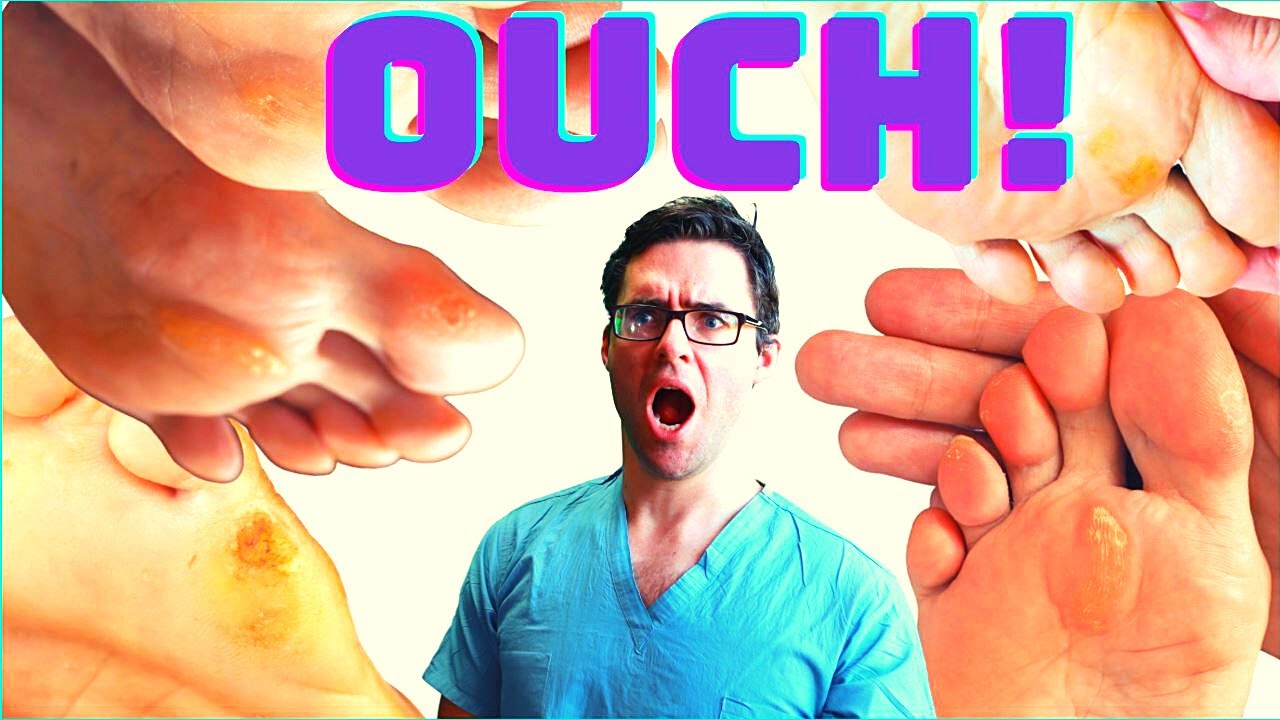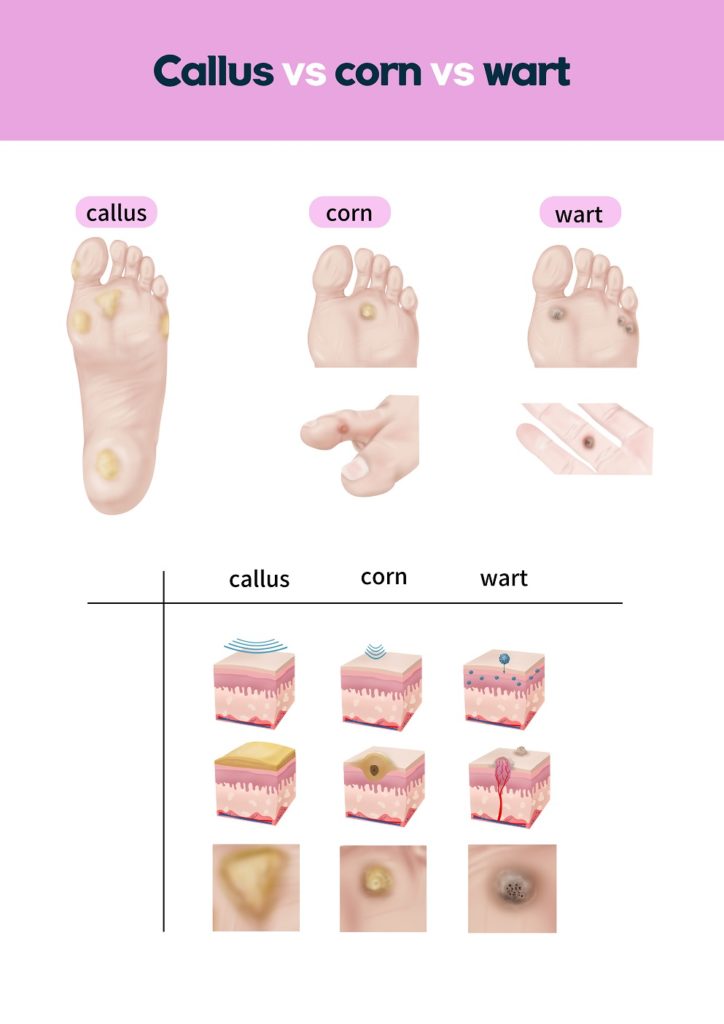What a Podiatrist Can Do For YOU!
Wart vs. Callus vs. Corn [Plantar Wart Vs. Plantar Callus Vs. Corn on Foot]
What is the difference between a corn, a wart or a callus? We review a foot plantar wart vs corn, a plantar wart vs callus & how to FIX THEM!
Table of Contents
Plantar wart vs corn vs callus treatment video:
Corns vs Warts vs Calluses video summary:
🦶 Do you have a Plantar Wart? A Foot Corn, Toe Corn, or Foot Callus? 🦶
We go over the TOP 20 BEST Home Remedies & Home Treatments! Learn the difference between plantar warts vs. corns vs. calluses.
Learn the BEST Home Remedies & Home Treatments for your plantar wart removal, foot callus, foot corn, toe callus & toe corn pain! The 3 most common lesions on the toes or feet are corns on the feet, warts on the foot, corns on the toes, and foot calluses. We’ve got you covered with all of these!
Plantar warts can also be known as an HPV wart (human papillomavirus wart), a planters wart, or a plantar verruca. There are different types of warts: flat warts, filiform warts, common warts, periungual warts, and warts on feet.
Plantar wart vs corn vs callus infographic:
Plantar Wart vs. Corn & Plantar Wart vs. Callus:
Have you ever experienced thick, hardened layers of skin on your feet? These lesions may be corns or calluses. Both can develop naturally when your skin tries to protect itself from frequent friction and pressure. Corns and calluses develop not only on your feet and toes but also on your hands and fingers. They can appear unsightly and may cause you to worry. However, these are not life-threatening conditions and can be treated easily by a podiatrist. They can be left untreated if they do not bother you, cause no pain or discomfort. However, if you are a patient with diabetes or you suffer from conditions that lead to poor blood circulation to your feet, you need to take it seriously and seek treatment early, as you are at a greater risk for developing complications.
Corns and calluses are not the same lesions, although there are many similarities.
What are the similar symptoms common to both corns and calluses?
- Both corns and calluses are rough and have a thick area of skin
- They have raised bumps hardened on top due to thick skin.
- If you press on it, this may cause pain. Pain sensitivity is known as tenderness.
- Both corns and calluses may have a dry, flaky, or waxy skin
Foot corn VS callus – what are the differences?
Although it may be difficult to distinguish corn from a callus by yourself, you may find several differences in appearance, the site they are found, and the severity of pain they cause you.
Differences in appearance
Corns are small in size; they have a hard center that is surrounded by inflamed skin. A corn may be either soft or hard on top. A soft corn will appear moist and macerated because of the fluid collection and are prone to infection than hard corns. Corns are circular in shape and usually white in color.
Calluses have hard, thickened skin and may be larger than a corn. Their size and shape may vary. Calluses are pale or yellowish in color. The edges are less well-defined than a corn. A hard corn will look similar to a callus. Basically, corns are small lumps of hard skin, while calluses are larger patches of thick rough skin.
The difference in the site they grow
Corns may develop on parts of your feet that do not bear weight. Ex: top of your toes, in between toes and sides of your toes
Calluses develop mainly on weight-bearing areas of your feet, such as the soles, especially under the heels of your foot or the ball of the foot. Calluses can also appear on the knees and the palms of your hands due to friction.
Differences in how you experience pain
Corns can cause pain under the skin. Pain and swelling may increase if your corns are infected. When pressed, you can get tenderness on the corn. Calluses are rarely painful and usually non-tender. However, calluses can cause pain and tenderness when they get inflamed.
Causes of developing corns VS callus – any difference?
Repetitive actions and weight-bearing can give rise to frequent friction and pressure on certain areas of your feet. This is the main reason behind the development of both corns and calluses.
Wearing ill-fitting shoes and not wearing socks are reasons mainly for the development of corns but can be a risk factor for both.
If you play instruments frequently (as in guitar players’ fingertips) and use hand tools often (as in mechanics palm), they may result in calluses on your hands due to repeated pressure and friction. Writing too much can also give rise to calluses due to frequent pressure on your fingers. Foot deformities like bunions, hammertoes, bony spurs, and even arthritis (inflammation of joints) can be risk factors for developing corns and calluses.
Corn on foot VS callus – Diagnosis and Treatment
Whether it is a corn or a callus, it is best to seek treatment if it worries you, causes pain, or interferes with your day-to-day life. You may have tried several home remedies, but were you able to eliminate them? Or do they reappear? Then it is time to visit a podiatrist.
Podiatrists are the experts in this field, and you will get complete foot care and treatment. Whether it is a corn or a callus, never try to remove it without medical supervision, especially if you belong to the high-risk group.
What are the differences in treating corns and calluses by your podiatrist?
First, your podiatrist will correctly diagnose whether your lesion is corn or a callus by a complete physical examination of your feet. Sometimes X-Rays will be ordered to identify any underlying deformities such as bony spurs, hammertoes, and bunions.
Treatment will be started accordingly and will be more complicated when it comes to underlying foot deformities. Sometimes your podiatrist will remove the underlying bony prominences and bursa (fluid-filled sacs) underneath the skin, along with the removal of the corn and callus. Correction of foot alignment will sometimes be offered to prevent further recurrences.
A callus larger than a dime causes pain and is ulcerated must be removed by a podiatrist. Your podiatrist will pare down thickened skin by using a scalpel and trim the callus. There are no nerve endings, and because your callus contains just thickened dead skin cell layers, this procedure will not give you any pain. Dead skin will be carefully peeled off, and no local anesthetic will be needed. A podiatrist will do a great job, with simply no bleeding or pain, and the risk of infection is also minimal. You don’t have to worry because trimming is done gently.
The area will be numbed by a local anesthetic injection so that you will not feel any pain if your podiatrist does a complete callus removal.
Your podiatrist will use one of these professional treatments to get rid of your corn.
- Trimming – by using a tool like a surgical blade or a scalpel, your podiatrist will remove the thickened skin of the corn carefully. Thickened skin will be pared down by a surgical blade usually. A scalpel will be needed to trim large corns.
First, your podiatrist will trim the callus-like part of the corn, and the center is then cut out. This is known as enucleation. It will leave a cavity or a hole in the tissue but will fill up with healthy tissue while healing with time. Your podiatrist may fill this hole with silicone, acrylic, or polymer gel until the healing process is complete to prevent new corn formation.
- Prescribing orthotics – There are many shoe inserts and orthotics that can be tried before removing corns. Footpads can ease some discomfort. Toe splints can prevent your toes from rubbing against each other. Corns can be a recurring problem if you have a foot deformity like bunions, hammertoes, or bony spurs. So, custom-made and padded shoe inserts may be prescribed to prevent recurrences of corns.
- Chemical treatment – 40% Salicylic acid is used to dissolve the keratin from the thick dead skin of your corn.
Bone alignment surgery of the foot – Although rarely done, it may be recommended to reduce friction to prevent corns.
When it comes to prevention, similar approaches may work for both corns and calluses, such as;
- Wearing well-fitting shoes that give enough space for your toes. Avoid high heels and tight, pointy shoes.
- Use protective coverings like felt pads, bandages, or corn pads that are non-medicated – By using them can prevent areas that rub against your footwear. You can also try lamb’s wool or toe separators to prevent corns from developing in between your toes. Use heel pads and soft insoles in your shoes to prevent getting calluses.
- Wearing socks with shoes and sandals will prevent your feet from rubbing against the footwear and prevent you from both corns and calluses. Try to wear thick cushioned socks.
- Soak your feet in warm water to soften the corns and calluses.
- Use a pumice stone or a foot file regularly to remove hard skin
- Moisturize your feet well to keep the skin hydrated and soft
- Avoid standing for long periods and walking long distances
- Avoid going barefoot.
A good podiatrist will give you advice regarding prevention and self-care measures so that you can say ‘Bye’ to your corns and calluses forever.
Corn VS Callus VS Bunion
Now that we know the differences and similarities of corns and calluses let us find out how they are related to bunions. Bunions are enlarged bony prominences located near the big toe at the joint where it attaches to your foot. Bunions can be a risk factor for developing both corns and calluses. A bunion is medically known as ‘Hallux valgus,’ an overgrowth of the bone and skin leading to deformities and skin irritation.
References:
https://www.mayoclinic.org/diseases-conditions/corns-and-calluses/symptoms-causes/syc-20355946
https://www.mayoclinic.org/diseases-conditions/corns-and-calluses/diagnosis-treatment/drc-20355951
https://www.aad.org/public/everyday-care/injured-skin/burns/treat-corns-calluses


